
- •2007 Р.
- •3) Match a word in column
- •Rock Excavation in civil Engineering
- •Introduction to Remote Control Technology
- •Supplementary reading:
- •Introduction
- •Versatile Drillrig
- •Multiple Tasking in Western Australia
- •Improving Productivity
- •Exercises:
- •4) Give answers to the following questions:
- •Exercises:
- •1)Give Ukrainian equivalents of the following words and word combinations:
- •2) Give English equivalents of the following words and word combinations:
- •3)Fill the blanks with the necessary words and word combinations:
- •4) Quote the sentences in which these words and word combinations are used. Translate these sentences into Ukrainian:
- •5.Give answers to the following questions:
- •6. Tell what you know about:
- •Importance of Geology
- •Igneous Rocks
- •Investigation and Exploration
- •Exercises:
- •1) Give Ukrainian equivalents of the following words and word combinations:
- •4) Quote the sentences in which these words and word combinations are used:
- •5) Give answers to the following questions:
- •Exercises:
- •2) Give English equivalents of the following words and word combinations:
- •4) Quote the sentences in which these words and word combinations are used:
- •5) Answer the following questions:
- •6) Tell what you know about:
- •Vertical Crater Retreat
- •Exercises:
- •1) Give Ukrainian equivalents of the following words and word combinations:
- •2) Give English equivalents of the following words and word combinations:
- •3) Fill the blanks with the necessary words:
- •4) Quote the sentences in which these words and word combinations are used:
- •5) Answer the fallowing questions:
- •6) Tell what you know about:
- •Supplementary reading
- •Список використаної літератури:
- •«Наукова англійська мова»
Міністерство освіти та науки України
Криворізький технічний університет
Кафедра іноземних мов
Тексти та завдання
з дисципліни „Наукова англійська мова”
для аспірантів та здобувачів
за напрямом «Гірництво»
денної та заочної форм навчання
Кривий Ріг
2007 Р.
Укладачі: Н.О. Голівер, доц. канд. пед. наук
О.О.Мельнік, викладач
Відповідальний за випуск: О.О. Мельник
Рецензент: С.О. Скидан, докт. пед. наук, проф.
Тексти та завдання призначено для аудиторної та самостійної роботи аспірантів та здобувачів, які готуються до здачі кандидатського мінімуму з англійської мови.
Аутентичні тексти гірничого профілю і завдання до них, які представлені в друкованому та електронному варіантах.
|
СХВАЛЕНО: На вченій раді економічного факультету Протокол № 8 Від «10» 05 2007 р. |
Розглянуто: на засіданні кафедри іноземних мов Протокол № 46 Від «15» 01 2007 р. |
ПЕРЕДМОВА
Мета курсу наукової іноземної мови для аспірантів та здобувачів – опанування такого рівня знань, навичок і вмінь, який забезпечуватиме необхідну для фахівця комунікативну спроможність в сферах професійного та ситуативного спілкування в усній та письмовій формах.
Завданням методичних вказівок є подальший розвиток навичок оглядового, інформативного і глибинного читання на матеріалах оригінальної наукової інформації з фаху.
Навички з проглядного читання мають забезпечувати вміння ознайомлюватися з тематикою наукового матеріалу та у загальних рисах давати характеристику загального уявлення про його зміст.
Інформативне читання передбачає вміння прослідкувати розвиток теми і загальну аргументацію та розглянути головні положення змісту.
Навички глибинного читання відпрацьовуються на рівні повного і точного розуміння тексту.
Усний і письмовий переклад текстів з іноземної мови рідною рекомендується використовувати як засіб опанування іноземної мови, прийом розвитку навичок і вмінь читання та ефективний спосіб контролю повноти і точності розуміння.
Навчальними текстами і літературою для методичних вказівок слугувала оригінальна монографічна і періодична література, використовувались збірники оригінальних статей.
При складанні анотації статті або тексту рекомендується користуватися наступними функціональними категоріями:
передача фактичного змісту інформації;
передача емоційного ставлення до повідомлення;
передача інтелектуальних відносин (засоби виразу згоди/незгоди, упевненості/невпевненості того, що повідомляється);
структуризація дискурсу (оформлення введення в тему, розвиток теми, підбиття підсумків повідомлення).
Можна рекомендувати використовувати на початку анотації тексту наступні фрази:
Thetextdealswiththeproblemof…;
Thearticletouchesupon the issue of…;
The extract from the book is concerned with…;
The text is about…;
The extract centers round the problem of…;
The problem of the text is of great importance…, etc.
Що стосується фонетичних навиків, для аспіранта важливо інтонаційне оформлення речення, фонологічне зіставлення, важливі для мови, що вивчається. Рекомендується робота з корекції вимови (робота з транскрипцією слів та інтонацією виразів і речень).
Quarring and Open Pit Mining
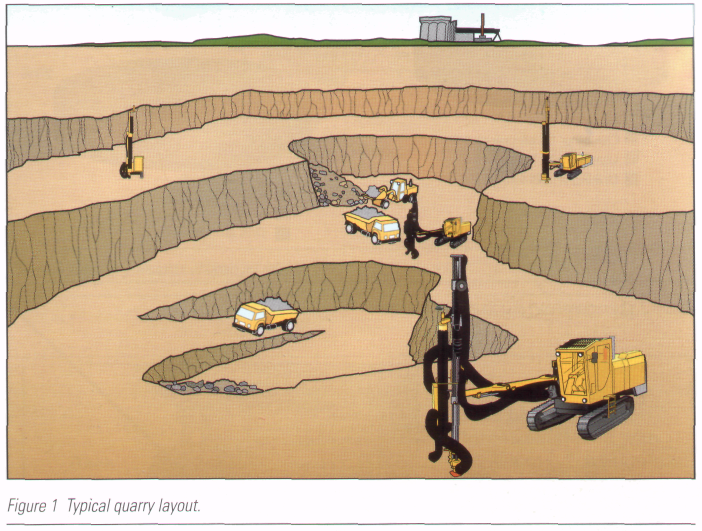
Finding the Best Combination
Large quantities of raw material are produced in various types of surface operations. Where the product is rock, the operations are known as quarries. Where metallic ore or non-metallic minerals are involved, they are called open pit mines. There are many common parameters in design and choice of equipment, and in the process of finding the best combination of drilling and blasting methods. Atlas Copco has the advantage of long experience in all types of surface drilling operations, with a product range to match. With its history of innovative engineering, the company tends to think forward, and is able to advise the user on improving design elements of the operation that will result in overall cost savings.
Quarries
A quarry is a factory that converts solid bedrock into crushed stone. The excavated rock is crushed, screened, washed and separated into different sizes, for subsequent sale and use. The amount of fines should be kept to a minimum. The final products are used as raw material for chemical plants, such as limestone for cement manufacturing, paper and steel industries, and clay shales for building materials, or as raw material for concrete aggregates, highway construction, or other civil engineering projects.
Not all types of rock are suitable as raw material for crushed stone. The material must have certain strength and hardness, and the pieces acquire a defined shape with a rough surface. Consequently, soft sedimentary rock, and material which breaks into flat, flaky pieces, are unacceptable. Igneous rock such as granite and basalt, as well as old Precambrian highly metamorphic rock such as gneiss, are well suited.
Quarries are normally run by operators who sell their products to nearby contractors and road administrators. This means that in areas where construction activities are high, several competing quarries may be established. Apart from environmental aspects, such operations can disturb the neigh bouring area in the form of noise from drilling, vibrations from blasting, and dust from crushing and screening. Quarries, wherever possible, are therefore discreetly located, as close as feasible to the construction area, because the products are transport cost sensitive.
Quarries can be either of the common pit type or, in mountainous terrain, the hillside type. Pit type quarries are opened up below the level of surrounding terrain, and accessed by means of ramps (Figure 1). The excavation is often split into several benches, depending on the depth of the operations. In its first stage, when the terrain is rough and bulldozers cannot provide a flat floor, a top-
hammer
construction
type drillrig can be used to
establish the first bench. Once the first
bench is prepared, production drilling
is preferably carried out using DTH-
or COPROD techniques.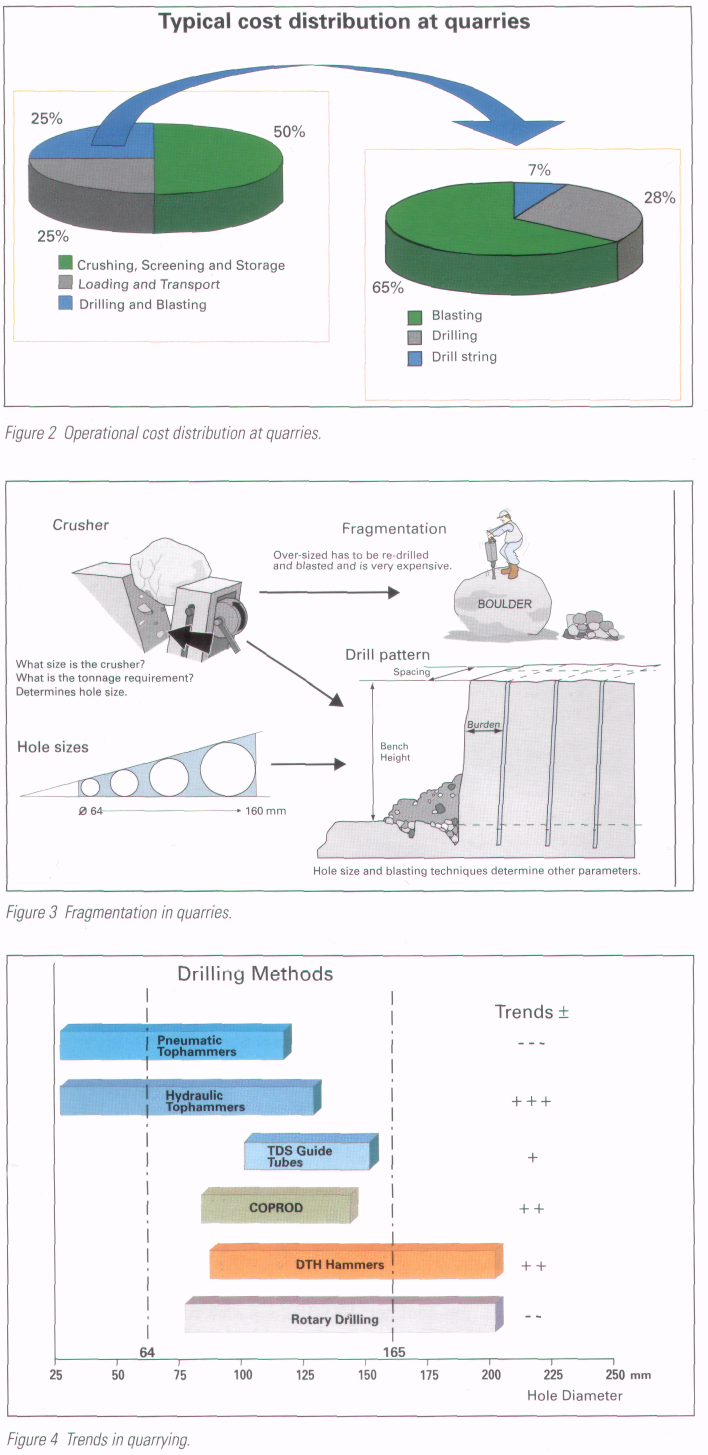
Shallower Benches
Whereas high benches, above 30 m, were previously quite common, nowadays they are shallower, for improved safety and economy. The width of the bench should be sufficient both to accommodate the spread of rock blast, and to provide space for the equipment.
The height of the working face in hill-type quarries is determined mainly by the topography.
A typical work cycle in a quarry consists of a number of work elements. Drilling of blastholes is undertaken in a predetermined pattern, followed by plugging the drill holes with wooden or plastic plugs to prevent debris from falling down into the holes.
When an adequate number of holes have been drilled, preparations for blasting will start. The holes are blown clean with compressed air to remove water and rock fragments, and are then charged with a booster bottom charge, detonators and explosives. Stemming is inserted into the top of each hole, and the detonator leads are connected. Where electric detonators are used, thе circuit resistance is checked with an ohmmeter. The area is evacuated, equipment is moved away, and the round is fired.
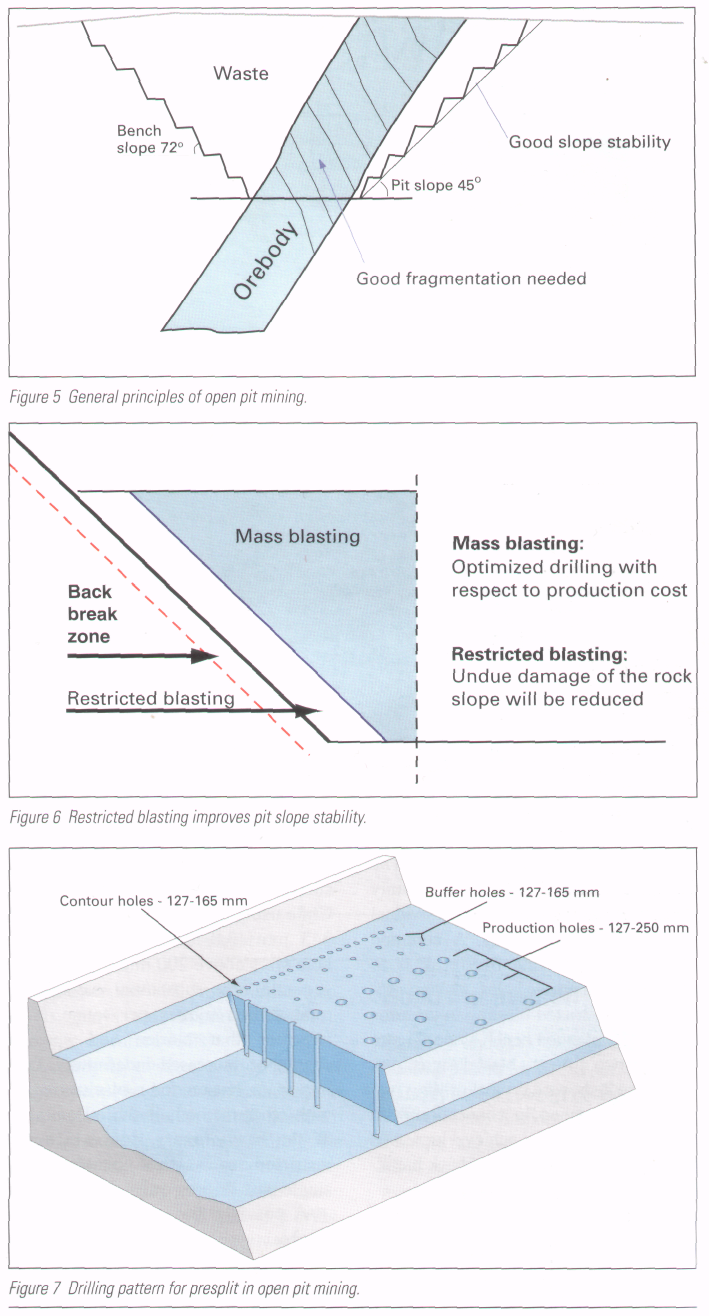 Before
loading, the lower quarry floor
is cleaned of fly rock with a wheel
loader. Blasted rock is then loaded
into trucks, and transported to the
crusher station. Large boulders are pushed
aside, and stockpiled for sub-sequent
secondary breaking. Rock is discharged
directly, or via a grizzley for
size control, into the primary crusher.
Thereafter, it is transported by conveyor
belts for secondary, and possibly
tertiary, crushing.
Before
loading, the lower quarry floor
is cleaned of fly rock with a wheel
loader. Blasted rock is then loaded
into trucks, and transported to the
crusher station. Large boulders are pushed
aside, and stockpiled for sub-sequent
secondary breaking. Rock is discharged
directly, or via a grizzley for
size control, into the primary crusher.
Thereafter, it is transported by conveyor
belts for secondary, and possibly
tertiary, crushing.
The different products, comprising rock fragments of certain size ranges, are recovered from the process by vibrating screens, and transported to storage silos or bunker piles on the ground.
Optimum Efficiency
There are various factors to be considered when trying to achieve optimum efficiency and overall economy from quarrying operations, the most important of which is cost reduction. Figure 2 illustrates a typical cost distribution between drilling and blasting, loading and transport, and crushing, screening and storage. It should be noted that crushing, screening and storage represent about half of the costs, whereas drilling represents less than 10%. More often than not, the crushing operation is the bottleneck in the total workcycle. *It is sometimes the case that extra expenditure in drilling and blasting might be the only way to assure free flow through the crusher, in order to utilize full capacity in the plant, and improve overall economy.
From an economics viewpoint, however, it is obvious that large-size crushers are primarily designed to handle large amounts of rock material, rather than large-size material. Therefore, it is worth assessing the rock fragmentation derived from the drilling and blasting cycle, in case some additional investment in drilling is the answer (Figure 3).
The whole chain of activities lead-ing to the final product of crushed material must be considered when optimizing total costs.
Drilling costs depend on the hole size and drilling density, in which accuracy of drilling is a factor; blasting costs depend on the amount and type of explosives, and number of detonators; and loading, transport and crushing costs depend on quarry floor roughness, and fragmentation.
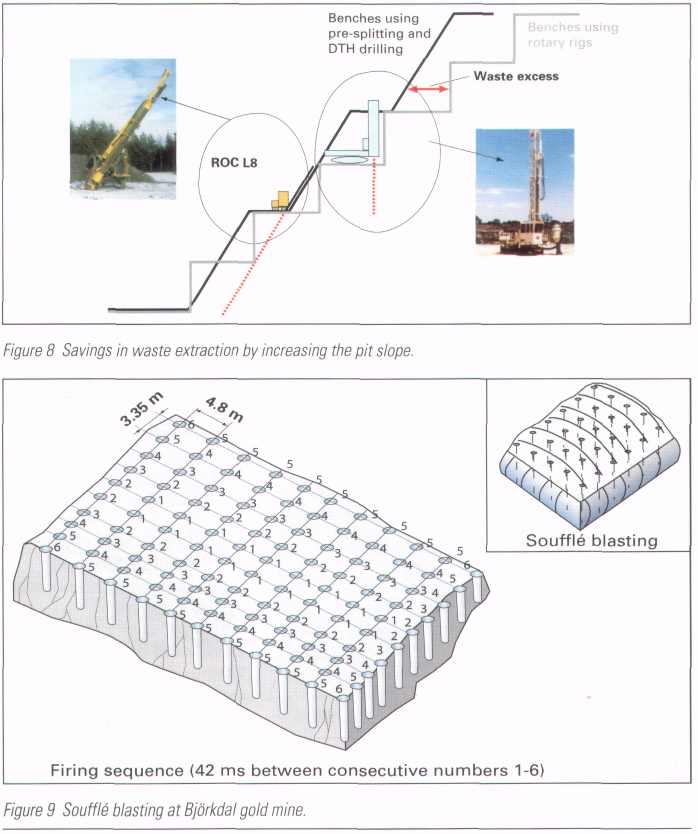
For most drilling applications, the optimum ratio between bench height and burden seems to be in the range of 3 to 4, indicating that hole diameters of 125-165 mm (5-6 in) are best for a bench height in the order of 18 m.
Figure 4 shows the trends in choice of drilling method. There is a clear movement towards more hydraulic tophammer, COPROD-drilling and DTH, and away from pneumatic and rotary drilling.
Open Pit Mining
A major difference between open pit mining and quarries is the geological conditions and the demand characteristics on the blasted material. Whereas quarries deliver the majority of rock via the crushing and screening plant in various size fractions, the open pit mine attempts to deliver the ore as pure as possible via crushers to the dressing plant, consisting of mills, separators, and/or flotation, and/or biochemical systems, and finally to smelters, in order to convert minerals to metals.
As no orebodies have the perfect conical shape which is tailor-made for the geometry of a pit, vast quantities of waste usually have to be removed from both the hangingwall and the footwall in order to mine the ore.
Figure 5 shows a sectional layout of a typical pit. The waste-to-ore ratio increases as the pit gets deeper. Eventually, for economic reasons, the open pit will be abandoned, or underground mining will take over. Without jeopardizing slope stability, it is of prime importance to keep the pit slope angle as steep as possible, maintaining excavated waste at a minimum.
The demands on fragmentation of the waste, as it will not pass through the crushing/dressing system, are simple. It should merely suit the loading and trucking equipment used forsubsequent removal to the waste dump. On the other hand, good fragmentation of the blasted ore will make great savings in the total costs of the mineral dressing process.
Steep and Stable Slopes
Blasting will not only break the rock that is planned to be excavated, but will also cause damage to the slopes that form the boundaries of the pit. The extent of this overbreak is mainly dependent on the size of the individual charge and its proximity. A common means of minimizing overbreak is to use smaller diameter holes, making pro-vision for restricted blasting in the zone next to the planned bench slope. Figure 6 shows two different blast designs.
Figure 7 shows a typical drilling pat-tern to be applied in connection with pre-split blasting, to achieve increased slope stability with reduced back break.
Drilling Patterns
Traditionally, focusing on the drilling cost parameter, the predominant method in open pit mining has been large hole rotary drilling using hole sizes in the 250 to 400 mm (10-15.75 in) range. No doubt this implies lower cost for drilling, ignoring the expense of excess waste and less
favourable fragmentation. A recent survey of 36 open pit operations in Chile using hole sizes between 75 and 345 mm (3.0-13.75 in) reveals that hole sizes above 200 mm (8 in) do not generate any substantial savings in total drilled metres per tonne. This indicates that burden and spacing cannot be increased indefinitely. One important reason for replacing rotary with other methods is the inflexibility of the heavy rotary rigs, which are restricted to vertical benches and single pass drilling only.
A possible, but not advisable, step in obtaining smaller holes, is to adapt rotary rigs to DTH drilling, by adding a high-pressure compressor to the rig. As the need for wide benches to cope with the inflexibility of the rotary rig still remains, this measure will not derive the full potential benefits of the DTH drilling method.
Figure 8 shows the advantages related to using an Atlas Copco ROC L8 rig, having the ability to drill inclined holes close to the bench wall, compared to a traditional rotary rig.
Souffle Blasting
Mining of rich, narrow and irregularly stratified ore zones, such as gold mineralizations, requires extra attention, in order not to introduce unnecessary quantities of waste into the ore stream. Consequently, this type of mining has to be progressed on a selective basis, in close liaison with surveyors and geologists, and taking frequent samples before and after each individual blast. Short benches and small holes are used to cope with ore zone irregularities. A recently-developed method to ensure maximum recovery from each blast is called souffle blasting. Figures 9 illustrate this principle of cautious blasting with a minimum of dilution as practised at the Bjorkdal gold mine in Sweden. To a depth of merely 5 m, 100 vertical holes are blasted in one round, without free surface for expansion. The firing sequence starts in the centre and, thanks to 2.5 m of stemming, the blasted ore material just swells on site like baking a souffle. Selective extraction by backhoe loaders facilitates maximum recovery of the rich, narrow gold-bearing zones.
Lists of words
1. quantity –маса
2. quarry – кар’єр
3. working face – очисний вибій
4. crushing – дроблення
5. dilution - розубоження
6. bench -уступ
7. spread – простір, простягання
8. stemming – набивання шпура
9. charge -заряд
10. hanging wall – висячий бік
11. footwall – лежачий бік
12. stability – стійкість
13. waste to ore ratio – коефіцієнт
розкриву
14. cautious - обережний
15. waste – пуста порода
16. burden – лінія найменшого опору
17. fragmentation - фрагментація
18. overburden – розкрив
19. slope - похил
20. resistance – опір
Exercises:
1) Give the definitions of the following terms :
Quarry; open pit; surface operations; cost savings.
2) Read and give Ukrainian equivalents of the following international words:
Parameters, design, process, combination, method, operations, location, material, critical.
3) Match a word in column
A with a definition in column В :
a quarry 1. грохотіння
crushing 2. кам'яний кар'єр
screening З. подрібнення
separation 4. сепарація
raw material 5. осадочна порода
types of rock 6. метаморфічна порода
metamorphic rock 7. сировина
sedimentary rock 8. прилягаюча площа
neighbouring area 9. типи порід
10. feasible 10. економічно вигідний
4) Complete the following sentences :
A quarry is a factory that converts
The final products are used
Quarries are normally run by
The excavation is often split into several benches
A typical work cycle in a quarry
5) Tell what you know about:
Quarries
Shallow Benches
Optimum Efficiency
Open Pit Mining
Steep a Stable Hopes
Principles of Rock Drilling
Drilling for Excavation by Blasting
This reference edition deals with surface rock drilling used for the purpose of excavating rock by means of blasting. Other types of drilling, such as drilling for oil and water, mineral exploration, and grouting are excluded.
The reader is given a brief explanation of the various prevailing drilling methods, as well as an introduction to blasting technique, and the interrelation of drilling and blasting. Also discussed are the main parameters involved when planning and executing blasthole drilling at quarries, open pit mines and various types of civil engineering projects.
The range of Atlas Copco products, with references to the Atlas Copco internet home pages, are presented and discussed by comparing their suitability and expected productivity related to various applications. Updated case stories from different worksites in the world should prove interesting and beneficial, when planning and selecting methods and equipment for blasthole drilling applications.
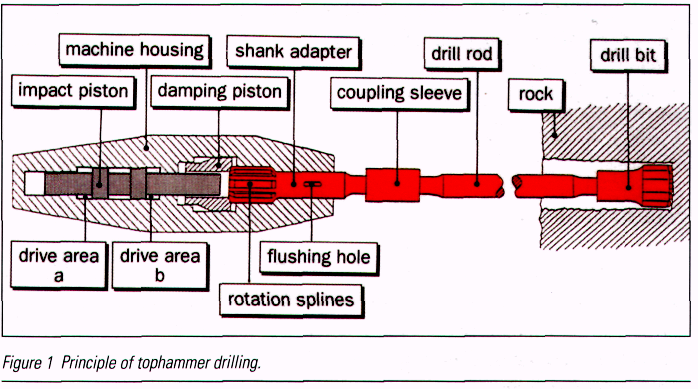
Rotary Drilling
Rotary drilling can be subdivided into rotary cutting and rotary crushing.
Rotary cutting creates the hole by shear forces, breaking the rock's ten sile strength. The drillbit isfurnished with cutter inserts of hard metal alloys and the energy for reaking rock is provided by rotation torque in the drillrod. This technique is limited to rock with low tensile strength, such as salt, silt, and soft limestone not containing abrasive quartz minerals.
Rotary crushing breaks the rock by high point load, accomplished by a toothed drillbit, which is pushed downwards with high force. The bit, being of tricone roller type fitted with tungsten carbide buttons, is simultaneously rotated, and drill cuttings are removed from the hole bottom by blowing compressed air through the bit.
Drillrigs used for rotary drilling are large and heavy. The downwards thrust is achieved by utilizing the weight of the drillrig itself, and the rotation, via a hydraulic or electric motor, applied at the end of the drill pipe. Common hole diameters range from 8 to 17.5 in (200-440 mm) and, because adding the heavy drill pipes is cumbersome, most blasthole drillrigs use long masts and pipes to accommodate single-pass drilling of maximum 20 m (65 ft). Electric power is usually chosen for the large rigs, whereas smaller rigs are often powered by diesel engines.
Rotation rates vary from 50 to 120 rev/min, and the weight applied to the bit varies from 0.5 t/in of bit diameter in soft rock, to as much as 4 t/in of bit diameter in hard rock.
Recent technical advances include: improved operator cab comfort; automatic control and adjustment of optimum feed force and rotation speed to prevailing geology and bit type and diameter; and incorporation of the latest technology in electric and hydraulic drive systems.
Rotary drilling, which is still the dominant method in large open pits, has limitations in that the rigs are not suited to drilling holes off the vertical line. As blasting theories and practice have proved, it is generally beneficial to design, drill and blast the bench slopes at an angle of approximately 18 degrees off vertical.
Many rotary rig masts have pinning capabilities permitting drilling at angles as much
as 30 degrees out of the vertical. However, the inclined hole drilling capabilities in rotary drilling are limited by the heavy feed force required, since part of this force is directed backwards. This causes rig stability problems, reduced penetration, and shorter life of drilling consumables. Consequently, most blast hole drilling using rotary drillrigs is for vertical holes.
Percussive Drilling
Percussive drilling breaks the rock by hammering impacts transferred from the rock drill to the drillbit at the hole bottom. The energy required to break the rock is generated by a pneumatic or hydraulic rock drill. A pressure is built up, which, when released, drives the piston forwards. Figure 1 illustrates the principle of top hammer percussive drilling.
The piston strikes on the shank adapter, and the kinetic energy of the piston is converted into a stress wave travelling through the drill string to the hole bottom. In order to obtain the best drilling economy, the entire system, rock drill to drillsteel to rock, must harmonize.
Stress Wave
Theoretically, the stress wave has a rectangular shape, the length of which is twice that of the piston, while the height depends on the speed of the piston at the moment of impact, and on the relationship between the cross-sectional area of the piston and that of the drillsteel.
The total energy that the wave contains is indicated diagramatically in Figure 2. To calculate the output power obtained from a rock drill, the wave energy is multiplied by the impact frequency of the piston, and is usually stated in kW. Rock drill designers seek to find the best combinations of various parameters, such as the piston geometry, the impact rate and the frequency. Two rock drills having the same nominal power rating might therefore have quite different properties.
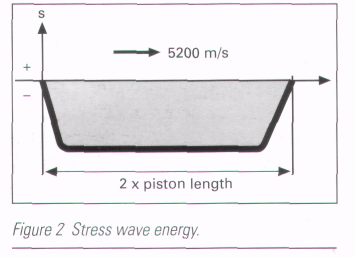
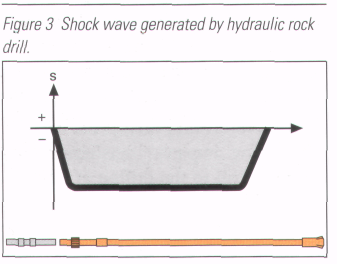
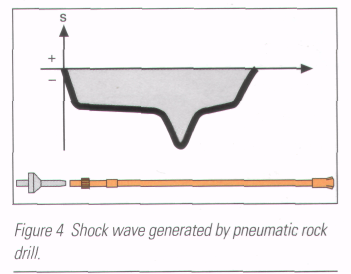
The shock waves that are generated by hydraulic (Figure 3) and pneumatic (Figure 4) rock drills are significantly different in shape. Drillrods used with hydraulic rock drills will normally show substantially longer service life, compared with pneumatic rock drills, because of the higher stress level obtained with the pneumatic driven piston.
The reason is the larger cross-section needed when operating at substantially lower pressure, which is 6-8 bars, compared to the 150-250 bars used with hydraulic systems. The slimmer the piston shape, the lower the stress level.
Figure 5 compares the stress level generated by three different pistons having the same weight, but with different shapes and working at different pressures. The lowest stress, or shock wave amplitude, is obtained with the long slender piston working at high pressure.
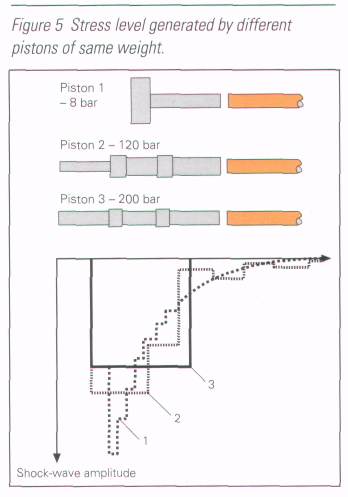
Efficiency and Losses
The wave loses some 6-10% of its energy for even, additional coupling, as it travels along the drillstring. This loss is partly due to the difference in cross-sectional area between the rod and the sleeve, and partly due to imperfect contact between the rod faces. The poorer the contact, the greater the energy loss.
When the shock wave reaches the bit, it is forced against the rock, thereby crushing it. The efficiency at the bit never reaches 100%, because some of the energy is reflected as a tensile pulse. The poorer the contact between the bit and the rock, the poorer the efficiency (Figure 6).
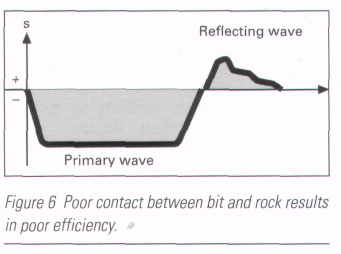
To optimize drilling economy, the drilling parameters for percussion pressure, feed force, and rotation must harmonize.
Percussion Pressure
The higher the pressure, the higher will be the speed of the piston, and consequently, the energy. Where the bit is in good contact with hard and competent rock, the shock wave energy can be utilized to its maximum. Conversely, when the bit has poor contact, the energy cannot leave the drillstring, and reverses up the drill-string as a tensile wave.
It is only when drilling in sufficiently hard rock that the maximum energy per blow can be utilized. In soft rock, to reduce the reflected energy, the percussion pressure, and thus the energy, will have to be lowered (Figure 7).
For any given percussion pressure, the amplitude, and hence the stress in the drillsteel, will be higher with reduced cross-section of the drillrods.

To get the longest possible service life from shank adapters and rods, it is important to ensure that the working pressure is matched to the drillstring at all times.
Feed Force
The purpose of the feed is to maintain the drillbit in close contact against the rock. However, the bit must still be able to rotate. The feed force must always be matched to the percussion pressure. Figure 8 illustrates this relationship.
Rotation
The purpose of rotation is to turn the drillbit to a suitable new position for the next blow. Using button bits, the periphery is turned about 10 mm between blows. Consequently, the rotation rate is increased using higher impact frequency and reduced bit diameter. Using insert bits, the recommended rotation rate is 25% higher.
Setting Parameters
In practice, the driller sets the percussion pressure that the rock can cope with, and then sets the rev/min with regard to the percussive frequency and the bit diameter.
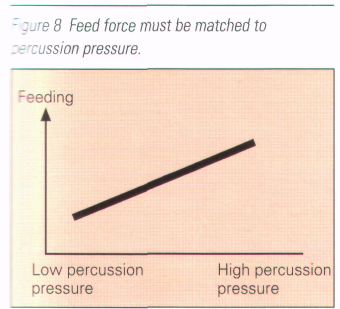
When drilling starts, the feed is adjusted to get even and smooth rotation. In case this is not achieved, which will show up in low shank adapter life, the percussion pressure can be progressively reduced, until even and smooth rotation is reached.
The temperature of the adapter sleeve can be checked to ensure that the drilling parameters are correctly set. Immediately after drilling, the temperature should be 60-70 degrees for dry drilling, and approximately 40 degrees for wet drilling.
Drilling problems, mainly related to loose couplings, may arise whatever parameters are used. In order to tighten the couplings during drilling, the friction of the bit against the hole bottom has to be increased. This can be done by increasing the feed, increasing the rotation rate, or changing the bit.
Flushing
Drill cuttings are removed from the hole bottom to the surface by air blowing or water flushing. As the power output from rock drills increases, accompanied by increased penetration rate, efficient flushing becomes gradually more important. The flushing medium is normally air for surface drilling, and water for underground drilling.
The required flushing speed will depend on: specific gravity - material having a density of 2 t/cu m requires at least 10 m/sec, whereas iron ore, for example, having a density of 4 t/cu m, requires an air speed of 25-30 m/sec; particle size - the larger the particles, the higher flushing speed required; particle shape -- spherical particles require more speed than flaky, leaf shaped particles.
Productivity and Methods
During the past century there has been a rapid and impressive increase in efficiency and productivity related to top hammer drilling. Starting from hitting a steel manually by a sledge hammer 100 years ago, today's hydraulically powered rock drills utilize the latest state-of-the-art technology.
Every drilling method has its pros and cons, making an objective comparison quite cumbersome. In view of this, the table in Figure 9 can serve as a guideline when comparing the various percussion drilling alternatives which Atlas Copco can offer. The choice of best drilling method to apply depends on hole size and type of application.
Lists of words
1. drilling – свердлування, буріння
2. rotary – ротаційний
3. rock – скеля, гірська порода
4. percussive –ударний
5. stress – тиск, напруження
6. rod – штанга
7. rotation –обертання
8. flushing - змивання
9. specifiс gravity – питома вага
10. pressure – тиск
11. drillstring – буровий снаряд
12. approximately - приблизно
13. drill cuttings – буровий дрібняк
14. hydraulically - гідравлічно
15. density – щільність, густина
16. penetration - проникнення
17. frequency - частота
18. relationship - взаємовідношення
19. accomplish – здійснювати
Exercises:
1) Give the definitions of the following terms :
Drilling, excavation, blast hole characteristics.
2) Read and give Ukrainian equivalents of the following international words:
Reference, excavating, method, interrelation, technique, planning, engineering, present, productivity, rotary, diameter, pneumatic, hydraulic.
3) Match a word in column
А with a definition in column В :
1. drillrigs 1. буровибухова свердловина
2 .blasting technique 2. діаметр свердловини
blasthole 3. 6ypoвий станок
hole diameter 4. бурова коронка
rotary drilling 5. методи буро-вибухових робіт
bit 6. похиле буріння
technical advances 7. роторне буріння
inclined hole drilling 8. nepepiз
crosscection 9. новi технічні рішення
10. drilling parameters 10. параметри буріння
4) Complete the following sentences :
Rotary drilling can be subdivided into
Drillrigs used for rotary drilling are
Rotation rates vary from
Percussive drilling breaks the rock
The higher the pressure, the higher
5) Tell what you know about:
Rotary Drilling
Percussive Drilling
Efficiency and Losses
Rotation
Productivity and Methods
Ergonomics and Safety
Drilling Efficiency
Efficient drilling is a function of many individual aspects, both mechanical and human. While it is necessary to have a powerful and easily-maneuverable drillrig, it is also important to take good cary of the operator's needs, and those of the external environment. What value is a machine that is too noisy, or cannot be operated in harsh weather? Operator comfort and safety has to be planned into the modern drilling at the drawing board stage of design. To get maximum return on investment, the owner needs to be sure that the drillrig is designed to work in all conditions, without the operator getting unduly tired, and with minimum disturbance of the environment in the neigh bourhood of the site. All Atlas Copco drill-rigs are designed with these parameters in mind.
In addition, a whole array of options is available to control the inclination, alignment and depth of drillholes, in order to get the maximum rock breaking effect from the minimum drilling effort, reducing noise and dust, and saving time, money, and materials.
Operator's Cabin
The interplay between man and machine starts in the operator's cab, and Atlas Copco has expended great effort in the development of a well conceived, purpose-built cab. Even the smallest details have been considered to produce a modern workstation, not only' in terms of mechanical function, but also paying attention to the requirements of ergonomics, safety and the environment. The cabin offers a superb view of the drillhole from the operator's seat, facilitating accurate collaring and control of the drilling operation. The angled, laminated glass windscreen is equipped with a large wiper, as are the right hand side and roof windows, and improved air ventilation effectively clears condensation mist from all of these windows. A jumbo-sized rear-view mirror gives good visibility and safer rig moving. In addition, the spacious cab gives good moveability and comfort for the operator, with easy-to-read instrumentation that is simple to learn and to use. A mechanized tube-permutation system enables any damaged drill rods to be identified from the operator's cab. The service hatches are easily accessed, but are also lockable, as a good security precaution at isolated worksites. The cabins are even equipped with a 12-volt outlet for mobile telephone.
Ergonomics and Environment
The cabin is laid out so that the operator can monitor and control the entire drilling process without changing body position. This relieves neck, shoulders and back from strain. The ergonomically-designed seat is vertically and laterally adjustable, with control levers and control panel located in, or in close proximity to, the collapsible arm rests. The seat is slewable for easy entry into the cab, and the door is fitted with a safety stop that prevents crushed fingers.
Good insulation affords a noise level below 80 dB, and rubber-damping of the cab mounting reduces vibration and gives greater comfort during tramming. The cabin has an efficient CFC-free air conditioning system for both cooling and heating, and many surfaces are textile covered for greater comfort.
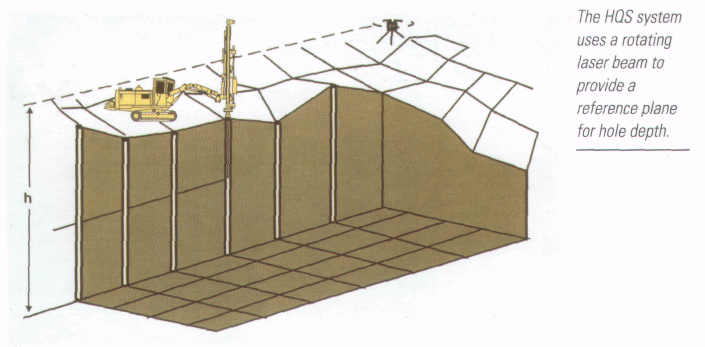 The
cab complies with the European and
international safety demands for
Roll-Over Protective Structure
The
cab complies with the European and
international safety demands for
Roll-Over Protective Structure
(ROPS) and Falling Object Protective Structure (FOPS).
With regards to the environment, exhaust emission values of all new Atlas Copco drillrigs are lower by a good margin than those stipulated in international standards, as are the noise values. There is efficient dust collection and coarse separation, the feeds are fitted with collectors for lubricating oil, and biologically degradable hydraulic oils are available as options.
Hole Alignment
Regulations governing rock blasting in open-air excavations are found in countries all over the world. Rock excavation by drilling and blasting is a particular menace in quiet, urban areas, and it is strictly governed with respect to allowable levels of pressure shocks and ground vibrations.
Productivity, and the need to control ground vibrations, means that capable and precise instruments are required to guide the driller. Faults in blasthole direction, hole deviations, and variations in hole depths must be minimized, if efficient production is to be obtained. Instruments for angle set-ting and hole depth control increase drilling accuracy and reduce human error.
There are various ways for a con-tractor to comply with the blasting rules, without increasing costs for rock excavation. Several benefits can be obtained from improved blasthole alignment and drill depth control. Improved accuracy in the application of the drilling pattern saves time, drill-metres, and explosives. At the same time, less boulders need to be broken, and less crushing of oversize is required. All this means reduced operating cost, and money saved. A modern hole alignment instrument offers: more precise drilling with a reduction in cost/hole; automatic depth control; better fragmentation; automatic drill feed stop; flat benches after blasting; and less overdrilling. By guaranteeing a perfect blast result, there is no need for the contractor to return and clean up rough surfaces, or condition overbreak.
Much blasting inconvenience can be reduced by special drilling patterns, which distribute the explosive charges evenly, and limit the level of ground vibrations, so as not to harm property in the vicinity. To achieve this, it is crucial to collar the hole on the right spot, maintain the correct alignment, and drill to a predetermined level.
Depth Control
The alignment instrument confirms the hole angle, while a laser sensor monitors drilling to the proper depth, regardless of the surface conditions. All this comes together for a successful blast, breaking rock to a level floor, with minimum ground vibration, and even fragmentation.
The HQS and the HEC3 angle set-ting instruments, used with the aiming device, helps set the correct angle of inclined holes.
The angle and hole depth reader function controls the length of a blast hole, from the start of the hole on surface, to the preset bottom elevation. The instrument does not require any assistance from the operator, and comes with an automatic drill feed stop function for optimum drilling accuracy.
The instruments feature automatic compensation, regardless of the drilling surface ground conditions. A beacon, mounted on a tripod, generates a horizontal reference plane on a 350 m radius across the worksite by a rotating laser beam. A sensor, fitted to the rock drill cradle, reacts to the signal generated by the rotating laser beam. The HQS 12 instrument pro-vides a reference plane for all holes, automatically adjusting hole depth to match the plan, with an accuracy within 5 cm.
Lists of words
1. efficiency –продуктивність
2. operator - машиніст
3. environment – навколишнє середовище
4. alignment – вирівнювання, вивіряння
5. cradle - рама
6. vibration - вібрація
7. margin –край
8. degrade - руйнувати
9. blast – вибух
10. adjusting – пристрій
11. collaring - забурювання
12. boulder - негабарит
13. condition - умова
14. pattern - контур
15. hole deviation – відхилення свердловини
16. worksite - робоче місце
17. insulation - ізоляція
18. fragmentation - фрагментація
19. dust collection - пиловловлювання
20. drill feed – подача бура
Exercises:
1) Give the definitions of the following terms :
Ergonomics, drilling efficiency, operator comfort
2) Read and give Ukrainian equivalents of the following international words:
Ergonomics, efficiency, function, individual aspect, mechanical, human, comfort, modern, maximum, conditions.
